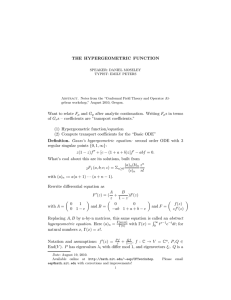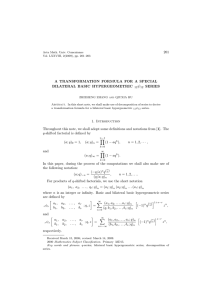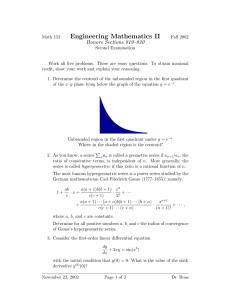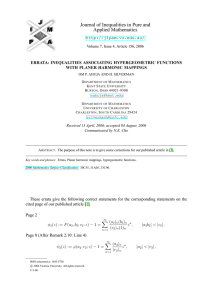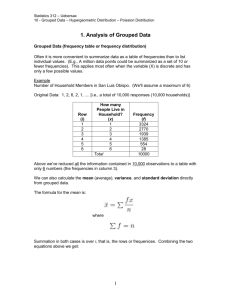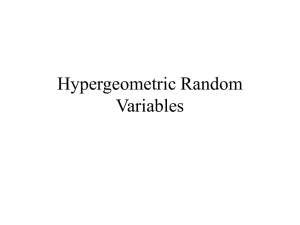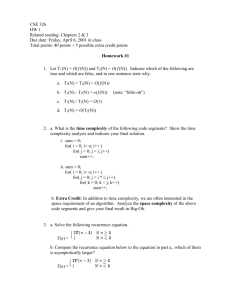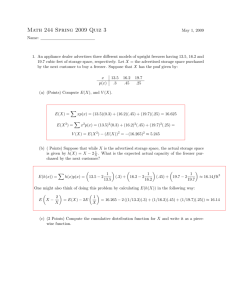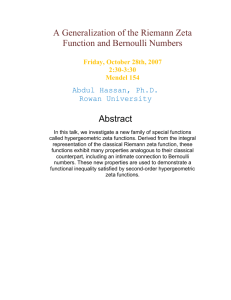Document 10838675
advertisement
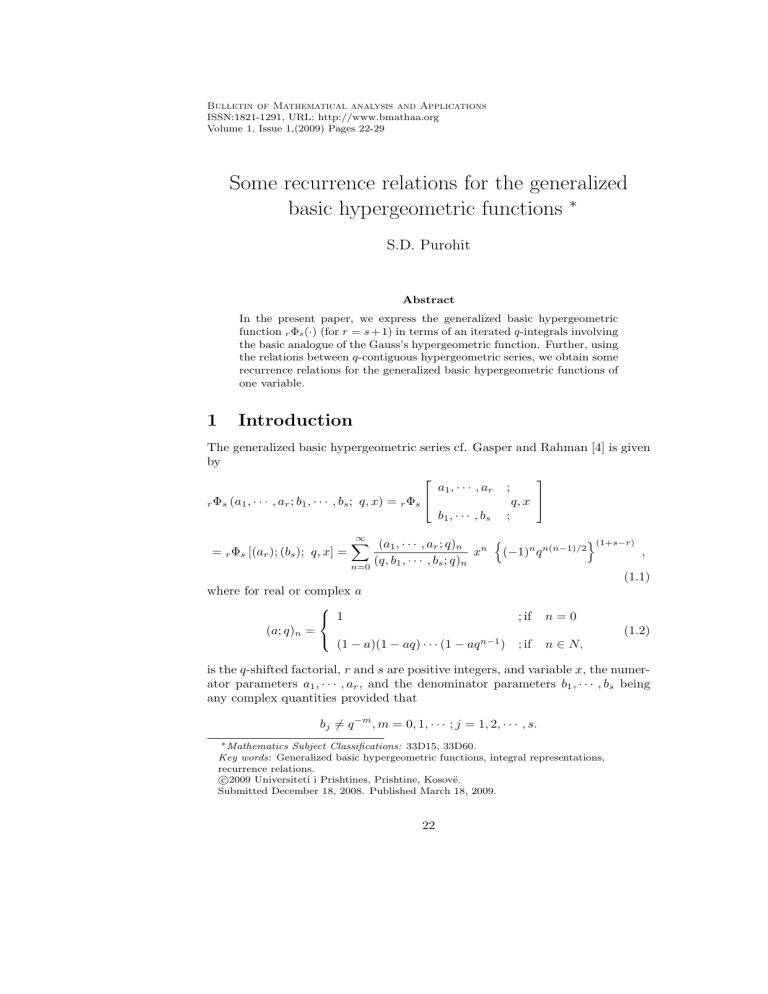
Bulletin of Mathematical analysis and Applications
ISSN:1821-1291, URL: http://www.bmathaa.org
Volume 1, Issue 1,(2009) Pages 22-29
Some recurrence relations for the generalized
basic hypergeometric functions ∗
S.D. Purohit
Abstract
In the present paper, we express the generalized basic hypergeometric
function r Φs (·) (for r = s + 1) in terms of an iterated q-integrals involving
the basic analogue of the Gauss’s hypergeometric function. Further, using
the relations between q-contiguous hypergeometric series, we obtain some
recurrence relations for the generalized basic hypergeometric functions of
one variable.
1
Introduction
The generalized basic hypergeometric series cf. Gasper and Rahman [4] is given
by
a1 , · · · , ar ;
q, x
r Φs (a1 , · · · , ar ; b1 , · · · , bs ; q, x) = r Φs
b1 , · · · , b s ;
∞
o(1+s−r)
X
(a1 , · · · , ar ; q)n n n
x
(−1)n q n(n−1)/2
,
(q, b1 , · · · , bs ; q)n
n=0
(1.1)
where for real or complex a
; if n = 0
1
(a; q)n =
(1.2)
(1 − a)(1 − aq) · · · (1 − aq n−1 ) ; if n ∈ N,
= r Φs [(ar ); (bs ); q, x] =
is the q-shifted factorial, r and s are positive integers, and variable x, the numerator parameters a1 , · · · , ar , and the denominator parameters b1 , · · · , bs being
any complex quantities provided that
bj 6= q −m , m = 0, 1, · · · ; j = 1, 2, · · · , s.
∗ Mathematics Subject Classifications: 33D15, 33D60.
Key words: Generalized basic hypergeometric functions, integral representations,
recurrence relations.
c 2009 Universiteti i Prishtines, Prishtine, Kosovë.
Submitted December 18, 2008. Published March 18, 2009.
22
S.D. Purohit
23
If |q| < 1, the series (1.1) converges absolutely for all x if r ≤ s and for
|x| < 1 if r = s + 1. This series also converges absolutely if |q| > 1 and
|x| < |b1 b2 · · · bs |/|a1 a2 · · · ar |.
Further, in terms of the q-gamma function, (1.2) can be expressed as
(a; q)n =
Γq (a + n)(1 − q)n
,
Γq (a)
n > 0,
(1.3)
where the q-gamma function (cf. Gasper and Rahman [4]) is given by
(q; q)∞
(q; q)a−1
=
,
a−1
− q)
(1 − q)a−1
Γq (a) =
(q a ; q)∞ (1
(1.4)
where a 6= 0, −1, −2, · · · .
The theory of basic hypergeometric functions of one and more variables has
a wide range of applications in various fields of Mathematical, Physical and
Engineering Sciences, namely-Number theory, Partition theory, Combinatorial
analysis, Lie theory, Fractional calculus, Integral transforms, Quantum theory
etc. (see [1,2,4,5])
In the present work, we express the generalized basic hypergeometric function
s+1 Φs (·) in terms of an iterated q-integrals involving the q-Gauss hypergeometric function 2 Φ1 (·). Using q-contiguous relations for 2 Φ1 (·), we obtain some
recurrence relations for the generalized basic hypergeometric functions of one
variable. The above mentioned technique is a q-version of the technique used
by Galué and Kalla [3].
2
Integral representation
In this section, we express the generalized basic hypergeometric function r Φs (·)
(for r = s + 1) in terms of an iterated integral involving the basic analogue of
Gauss hypergeometric function.
Theorem: Let Re(bs−i ) > 0, for all i = 0, 1, · · · , s − 2 and |q| < 1 , then the
iterated q-integral representaion of s+1 Φs (·) is given by
s+1 Φs
q α , q β , a3 , a4 , · · · , as , as+1
q, x =
q γ , b2 , b3 , · · · , bs
Z
×
0
|
1
;
Z
···
{z
;
1 s−2
Y
0
}
(s−1)times
i=0
a
s+1−i
ti+1
s−2
Y
i=0
−1
Γq
bs−i
as+1−i , bs−i − as+1−i
(ti+1 q; q)bs−i −as+1−i −1
24
Some recurrence relations
qα , qβ
× 2 Φ1
q
γ
;
q, ts−1 · · · t2 t1 x dq ts−1 · · · dq t2 dq t1 , (2.1)
;
where |x| < 1 and |ts−1 · · · t2 t1 x| < 1.
Proof: To prove the theorem, we consider the well-known q-integral representation of r Φs (·), namely
a1 , · · · , ar ;
bs
q,
x
Φ
=
Γ
r s
q
as+1 , bs − as+1
b1 , · · · , b s ;
Z 1
a1 , · · · , ar−1 ;
q, tx dq t, (2.2)
×
tar −1 (tq; q)bs −ar −1 r−1 Φs−1
0
b1 , · · · , bs−1 ;
which is the generalization of q-analogue of Euler’s integral representation,
namely (cf. Gasper and Rahman [4, eqn.(1.11.9), p.19])
a b
Z 1
q ,q ;
Γq (c)
q,
x
tb−1 (tq; q)c−b−1
Φ
=
2 1
Γq (b)Γq (c − b) 0
c
q
;
a
q
;
q, tx dq t.
(2.3)
× 1 Φ0
− ;
Therefore, relation (2.2) can also
α β
q , q , a3 , a4 , · · · , as , as+1
Φ
s+1 s
q γ , b2 , b3 , · · · , bs
be written as
;
bs
q, x = Γq
as+1 , bs − as+1
;
α β
Z 1
q , q , a3 , a4 , · · · , as ;
a
−1
q, t1 x dq t1 .
×
t1 s+1 (t1 q; q)bs −as+1 −1 s Φs−1
0
q γ , b2 , b3 , · · · , bs−1
;
(2.4)
Repeating the process in the right-hand side of (2.4), we get
α β
q , q , a3 , a4 , · · · , as , as+1 ;
bs
q, x = Γq
s+1 Φs
as+1 , bs − as+1
q γ , b2 , b3 , · · · , bs
;
Z 1 Z 1
bs−1
a
−1
×Γq
ta2 s −1 (t2 q; q)bs−1 −as −1 t1 s+1 (t1 q; q)bs −as+1 −1
as , bs−1 − as
0
0
α β
q , q , a3 , a4 , · · · , as−1 ;
q, t2 t1 x dq t2 dq t1 . (2.5)
×s−1 Φs−2
γ
q , b2 , b3 , · · · , bs−2
;
Successive operations (s − 3) times in the right-hand side of (2.5) leads to the
desired result (2.1)
S.D. Purohit
3
25
Recurrence relations
In this section, as an application of the integral representation for s+1 Φs (.),
given by (2.1), we shall derive certain recurrence relation for the generalized
basic hypergeometric series.
Using the relation between q-contiguous basic hypergeometric functions [4,
p.22]
α β
α β
q ,q
;
q ,q
;
(1 − q α )(1 − q β )
q, x − 2 Φ1
q, x = q γ x
2 Φ1
(q − q γ )(1 − q γ )
q γ−1
;
qγ
;
α+1 β+1
q
,q
;
q, x ,
× 2 Φ1
(3.1)
q γ+1
;
we get
2 Φ1
qα , qβ
q
γ
;
q, ts−1 · · · t2 t1 x = 2 Φ1
;
qα , qβ
q, ts−1 · · · t2 t1 x
γ−1
q
(1 − q α )(1 − q β )
− q γ ts−1 · · · t2 t1 x
2 Φ1
(q − q γ )(1 − q γ )
;
;
q α+1 , q β+1
q
;
q, ts−1 · · · t2 t1 x .
γ+1
;
(3.2)
On substituting value from relation (3.2) in the right-hand side of the result
(2.1), we have
α β
s−2
q , q , a3 , a4 , · · · , as , as+1 ;
Y bs−i
q,
x
Φ
Γ
=
s+1 s
q
as+1−i , bs−i − as+1−i
i=0
q γ , b2 , b3 , · · · , bs
;
Z
×
0
|
1
1 s−2
Y
Z
···
{z
0
a
s+1−i
ti+1
−1
(ti+1 q; q)bs−i −as+1−i −1
} i=0
(s−1)times
qα , qβ
× 2 Φ1
q
−q γ x
Z
×
0
|
1
Z
···
{z
}
(s−1)times
;
s−2
Y
Γq
i=0
1 s−2
Y
0
q, ts−1 · · · t2 t1 x dq ts−1 · · · dq t2 dq t1
γ−1
(1 − q α )(1 − q β )
(q − q γ )(1 − q γ )
;
i=0
1+a
bs−i
as+1−i , bs−i − as+1−i
ti+1 s+1−i
−1
(ti+1 q; q)bs−i −as+1−i −1
26
Some recurrence relations
q α+1 , q β+1
× 2 Φ1
q
;
q, ts−1 · · · t2 t1 x dq ts−1 · · · dq t2 dq t1 .
γ+1
(3.3)
;
Again, on making use of the result (2.1), the above result (3.3) leads to the
following recurrence relation:
α β
q , q , a3 , a4 , · · · , as , as+1 ;
q, x
s+1 Φs
γ
q , b2 , b3 , · · · , bs
;
q α , q β , a3 , a4 , · · · , as , as+1
;
= s+1 Φs
(1 − q α )(1 − q β )
q, x − q γ x
(q − q γ )(1 − q γ )
q γ−1 , b2 , b3 , · · · , bs
;
α+1 β+1
s−2
q
,q
, a3 q, a4 q, · · · , as q, as+1 q
Y (1 − q as+1−i )
×
Φ
s+1 s
(1 − q bs−i )
i=0
q γ+1 , b2 q, b3 q, · · · , bs q
;
q, x ,
;
(3.4)
where Re(bs−i ) > 0, for all i = 0, 1, · · · , s − 2 and |x| < 1.
Similarly, if we consider the following q-contiguous relations (cf. Gasper and
Rahman [4, p.22])
α β
α+1 β
q ,q
;
q
,q
;
(1 − q β )
q, x = q α x
q, x − 2 Φ1
2 Φ1
(1 − q γ )
qγ
;
qγ
;
× 2 Φ1
2 Φ1
q α+1 , q β
q γ+1
;
q, x − 2 Φ1
;
qα , qβ
;
qγ
;
q α+1 , q β+1
;
q γ+1
;
q, x ,
(3.5)
(1 − q γ−α )(1 − q β )
q, x = q α x
(1 − q γ+1 )(1 − q γ )
× 2 Φ1
q α+1 , q β+1
;
q γ+2
;
q, x ,
(3.6)
and
2 Φ1
q α+1 , q β−1
qγ
;
q, x − 2 Φ1
;
qα , qβ
;
qγ
;
(1 − q β−α+1 )
q, x = q α x
(1 − q γ )
× 2 Φ1
q α+1 , q β
;
q γ+1
;
q, x .
(3.7)
S.D. Purohit
27
and make use of the result (2.1), we obtain the following respective recurrence
relations for generalized basic hypergeometric functions, namely
α β
q , q , a3 , a4 , · · · , as , as+1 ;
q, x
s+1 Φs
γ
q , b2 , b3 , · · · , bs
;
q α+1 , q β , a3 , a4 , · · · , as , as+1
;
= s+1 Φs
β
(1 − q )
q, x − q α x
(1 − q γ )
q γ , b2 , b3 , · · · , bs
;
α+1 β+1
s−2
q
,q
, a3 q, a4 q, · · · , as q, as+1 q
Y (1 − q as+1−i )
×
Φ
s+1 s
(1 − q bs−i )
i=0
q γ+1 , b2 q, b3 q, · · · , bs q
;
q, x ,
;
(3.8)
where Re(bs−i ) > 0, for all i = 0, 1, · · · , s − 2 and |x| < 1.
s+1 Φs
q α , q β , a3 , a4 , · · · , as , as+1
;
q γ , b2 , b3 , · · · , bs
;
q, x
q α+1 , q β , a3 , a4 , · · · , as , as+1
;
= s+1 Φs
(1 − q γ−α )(1 − q β )
q, x − q α x
(1 − q γ+1 )(1 − q γ )
q γ+1 , b2 , b3 , · · · , bs
;
α+1 β+1
s−2
q
,q
, a3 q, a4 q, · · · , as q, as+1 q
Y (1 − q as+1−i )
Φ
×
s+1
s
(1 − q bs−i )
i=0
q γ+2 , b2 q, b3 q, · · · , bs q
;
q, x ,
;
(3.9)
where Re(bs−i ) > 0, for all i = 0, 1, · · · , s − 2 and |x| < 1.
s+1 Φs
q α , q β , a3 , a4 , · · · , as , as+1
;
q γ , b2 , b3 , · · · , bs
;
= s+1 Φs
×
s−2
Y
i=0
q, x
q α+1 , q β−1 , a3 , a4 , · · · , as , as+1
;
q γ , b2 , b3 , · · · , bs
;
(1 − q as+1−i )
(1 − q bs−i )
s+1 Φs
(1 − q β−α+1 )
q, x − q α x
(1 − q γ )
q α+1 , q β , a3 q, a4 q, · · · , as q, as+1 q
q
γ+1
;
q, x ,
, b2 q, b3 q, · · · , bs q
;
(3.10)
where Re(bs−i ) > 0, for all i = 0, 1, · · · , s − 2 and |x| < 1.
28
4
Some recurrence relations
Special cases
In view of the limit formulae
lim− Γq (a) = Γ(a)
and
lim−
q→1
q→1
(q a ; q)n
= (a)n ,
(1 − q)n
(4.1)
where
(a)n = a(a + 1) · · · (a + n − 1),
(4.2)
one can note that the result (2.1) is the q-extension of the known result due to
Galué and Kalla [3, eqn.(4), p.52], namely
s−2
α, β, a3 , a4 , · · · , as , as+1 ;
Y bs−i
x =
Γ
s+1 Fs
as+1−i , bs−i − as+1−i
i=0
γ, b2 , b3 , · · · , bs
;
Z
×
|0
1
Z
···
{z
0
1 s−2
Y
a
s+1−i
ti+1
−1
(1 − ti+1 )bs−i −as+1−i −1
} i=0
(s−1)times
α, β
;
ts−1 · · · t2 t1 x dts−1 · · · dt2 dt1 ,
× 2 F1
γ
(4.3)
;
where Re(bs−i ) > 0, for all i = 0, 1, · · · , s − 2, |x| < 1 and |ts−1 · · · t2 t1 x| < 1.
Similarly, if we let q → 1− and use the formula (1.4), then the results (3.4) and
(3.8)-(3.10) correspond to the recurrence relations for generalized hypergeometric functions.
We conclude with the remark that the results deduced in the present article
appears to be a new contribution to the theory of basic hypergeometric series.
Secondly, one can easily obtain number of recurrence relations for the basic hypergeometric functions by the applications of iterated q-integral representation
for r Φs (.).
Acknowledgements The author express his sincerest thanks to the referees
for some valuable suggestions.
References
[1] W. N. Bailey, Generalized Hypergeometric Series; Cambridge University
Press, Cambridge, 1964. Second edition.
[2] H. Exton, q-Hypergeometric Functions and Applications; Ellis Horwood
Limited, Halsted Press, John Wiley and Sons, Chichester, 1983.
S.D. Purohit
29
[3] L. Galué and S.L. Kalla, Some recurrence relations for the generalized
hypergeometric functions of the Gauss type, Fract. Calc. and Appl. Anal.
1(1), (1998), 49-62.
[4] G. Gasper and M. Rahman, Basic Hypergeometric Series; Cambridge University Press, Cambridge, 1990.
[5] L.J. Slater, Generalized Hypergeometric Functions; Cambridge University
Press, Cambridge, London and New York, 1966.
S.D. Purohit
Department of Basic-Sciences (Mathematics),
College of Technology and Engineering,
M.P. University of Agriculture and Technology, Udaipur-313001, India
e-mail: sunil a purohit@yahoo.com
